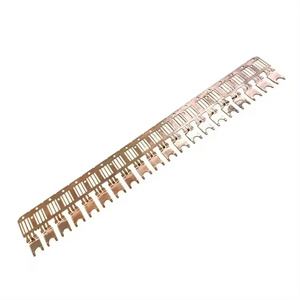Terminal connectors are widely used and important in communication equipment. As the key interface for current or signal transmission between components in the equipment, they ensure the normal operation and high efficiency of communication equipment. The following is a detailed summary of the application of Terminal Connectors in communication equipment:
1、 Ensure electrical connection and signal transmission
Stable and reliable connection:
Terminal Connectors ensures the stability and reliability of electrical connection between internal components of communication equipment through its design structure and material selection. They can withstand external factors such as vibration and impact generated during equipment operation to prevent loose or disconnected connection.
Efficient signal transmission:
In communication equipment, Terminal Connectors not only transmits current, but also transmits signals (such as electrical signals and optical signals). They require good conductivity and signal integrity to ensure that the signal is not distorted or attenuated during transmission to ensure communication quality.
2、 Different application scenarios
Diversified connector types:
Terminal Connectors come in a variety of types and specifications depending on application requirements. For example, plug connectors, board to board connectors, fiber connectors, etc., each connector has its specific application scenario and advantages. The manufacturer of communication equipment can select the appropriate connector type according to the design requirements of the equipment.
Compatibility and Standardization:
In order to facilitate equipment maintenance and upgrading, many communication equipment adopts standardized Terminal Connectors interface. This helps reduce the cost of production and allows users to purchase the right accessories in the market. Meanwhile, the standardized interface improves the compatibility and substitutability of the equipment.
3、 Supporting high-speed data transmission and communication
High-speed signal transmission capacity:
With the continuous development of communication technology, communication equipment has higher and higher requirements on data transmission rate. Terminal Connectors need the ability to support high-speed signal transmission to meet the equipment’s requirements for high-speed data transmission. For example, high-speed signal connectors in a board-to-board connector can provide data transmission rates up to dozens of Gbps.
Low signal loss and low standing wave ratio:
In the communication equipment, Terminal Connectors shall meet the functional requirements of low signal loss and low SWR to ensure no attenuation or reflection of signal during transmission. This helps to improve communication quality and reduce signal interference.
4、 Suitable for harsh working environment
Corrosion resistance:
In some communications equipment used outdoors or in harsh environments, Terminal Connectors require good corrosion resistance. They shall be able to resist the corrosion of connectors caused by severe environment such as moisture and salt mist, so as to ensure the stable operation of equipment under severe environment.
High and low temperature resistance:
In some special applications, the communication equipment needs to operate at high or low temperature. Terminal Connectors require high and low temperature resistance to ensure electrical connections and signal transmission are unaffected at extreme temperatures.
5、 Example of specific application scenarios
Connection between base station and antenna:
In wireless communication system, high performance Terminal Connectors are usually used for connection between base station and antenna. These connectors need to be able to withstand the transmission requirements of high current and high frequency signals, and ensure the stability and reliability of the connection.
Connection between data center and server:
In high-performance computing environments such as data centers and servers, Terminal Connectors are widely used for the connection between circuit boards and between equipment and systems. They need to support high-speed data transmission and signal integrity requirements to ensure efficient operation of the data center and servers.
